When the new California Academy of Sciences re-opened last year in San Francisco’s Golden Gate Park, the green roof was a big story with its central design concept-“lifting up a piece of the park and put a building under it”.
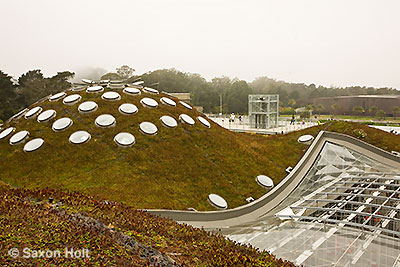
Green roof Academy of Sciences
I was eager to photograph it but could not get permission to walk out on the roof beyond the observation deck because I was not working on any real story. I just wanted to get some cool photos of the 2.5 acre native plant meadow on a roof, having just completed my meadow book and loving California native plants. Alas, there were so many requests for photo access to the roof, I was told quite politely to come back when I had a better excuse.
Now I am working on a project (about alternatives to lawn) and the publisher specifically asked for photos of Cal Academy’s roof. Visions of bright sunny meadows and colorful wildflowers danced in my head. The day I scheduled was typical San Francisco mid-summer fog – really foggy.
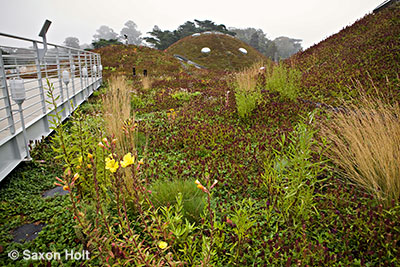
Native plant green roof by observation deck
Fog can be a garden photographer’s best friend, but wet drippy dense gray fog is almost as bad as rain as far as lenses and equipment are concerned, so I had to wait out the first hour of my time, waiting for the fog to lift a bit, impatient that the intern watching me was ready to cut off my time.
It is a good thing to wait for photos in a garden. Too often when we visit gardens we rush through not really seeing the essence, not letting the garden speak to us of what it is doing in that moment. In those moments on the roof of the Academy I began to see a garden being revitalized by the fog, a garden perfectly adapted to San Francisco, a living roof adapting to the climate.
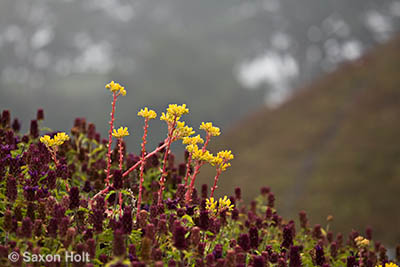
Dudleya on windswept foggy coastal cliffs are common in Northern California, so that idea became part of the day’s story on the San Francisco roof whose rolling “hills” cover rainforest exhibits and planetariums below.
Studying the Dudleya and noticing how well they were set off from the dominant groundcover on the roof, Selfheal (Prunella vulgaris). I “worked the scene” as I like to say, studying angles and the relationship of plants to each other. The angle that began to work was a very low one where I could see the whole profile of the plant, like a botanic illustration.
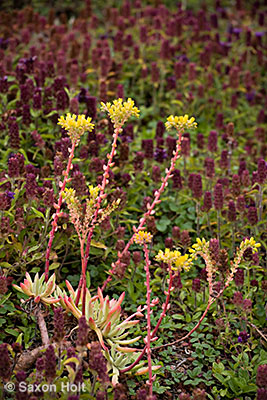
Dudleya and Prunella on living roof
Suddenly I began to see all the flowering plants juxtaposed against the Prunella. They all began to make sense in the fog, looking perky in a drought tolerant landscape. The Seaside Daisy (Erigeron glaucus) has become a staple in California landscaping, but its native habitat is the foggy edge of California. It looks quite happy on this rugged exposed rooftop.
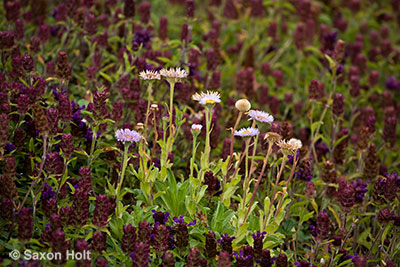
Erigeron, Seaside Daisy on living roof
After a while I began to be in a garden. Designed as a functional ecosystem on imported soil to insulate a roof and help the earth breathe, it took on the mantle of a garden. Granted, the designers of this green roof only planted the more colorful, meadowy wildflowers and grasses near the observation area, but even as the fog lifted enough to get wider photographs, the lesson, like my camera’s vista, became clear:
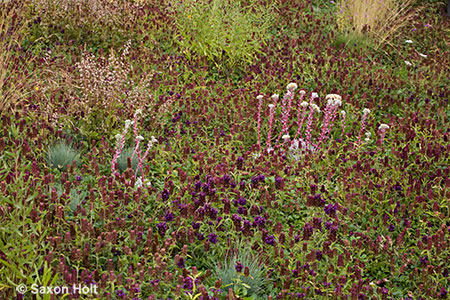
Rooftop cover, or garden groundcover ?
Native plants offer great groundcover alternatives to lawn – as well as to standard roofing. I think my publisher will be pleased. With a little help from the designers, the camera always lies.
